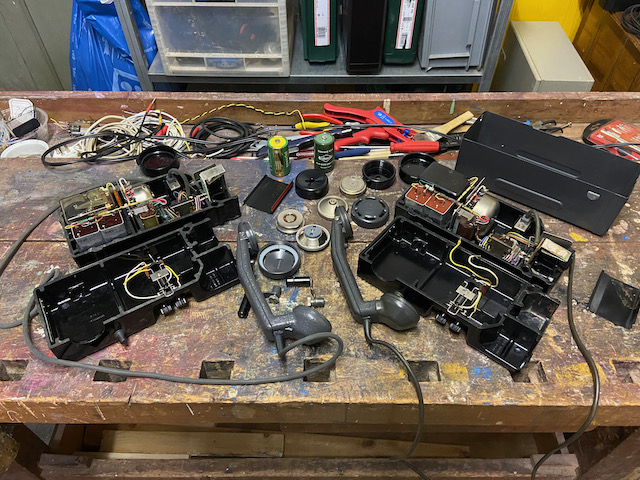
Find more details on Swiss field telephone history on the Swiss Army Field Telephones Timeline.
Developed in 1953 by Albiswerk Zürich A.G. based on the components from the F.Tf. 50 but for indoor use and with support for CB lines.
Initially called Tischtelephon (Table Telephone), T.Tf.53, later called Armeetelephon, A.Tf.53.
(All Albiswerk made are marked T.Tf. and all Gfeller made are marked A.Tf., there I was wrong, just got a Gfeller made with designation T.Tf., see latest pictures in gallery).
According to [1] and [2] about 7000 were made by Albiswerk until 1960 and a further 3000 by Gfeller between 1961 and 1963.
The datestamps found on the capacitors of instruments in my collection do not match that.
The earliest Albiswerk with serno. 266 has a capacitor date of 1955, the latest with serno. 9580 has 1966.
All Gfeller instruments in my possesion have sernos. >56000 >51000 and datestamps from 1976 >1975, the latest has serno. 62664 with date 1977.
It may be possible that the capacitors were replaced at a later date but as a need for capacitor replacement is quite rare I find it unlikely.
My sourceless assumption which may be totally wrong is that Albiswerk manufactured these until the late 60ies when Gfeller took over and manufactured into the late seventies.
Other indicators are that the Nummernschalterzusatz has been made by Albiswerk to at least 1968 (there the manufacturing date is stamped to the device itself and has not to be gleaned from the capacitor), and the user-guide from Albiswerk [3] is dated 1966.
The instrument uses the same magneto and ringer than the F.Tf.50. In contrast to the F.Tf. 50 the ringer coils are not used as transmission coil, a dedicated coil (anti-sidetone) has been added. The handset is also identical to the slim F.Tf.50 handset but without the P.T.T. lever as there is a hookswitch on the body. All is fitted inside a bakelite case with handset holding cups on top. A metal lid can be placed over the handset to close the instrument, when in use the same metal lid is placed beneath the instrument.
Description from "Albiswerk Zürich A.G., Tischtelephon T.Tf.53, Nummernschalterzusatz, Betriebsvorschrift und Bedienungsanleitung, 1966" [3] (Translated and slightly abridged):
The desk phone is built as a subscriber station for dry rooms. It is used in command posts. The station is suitable for both local battery operation with inductor call and central battery operation. Using the additional dial unit the desk phone can also be connected to the automatic telephone network of the PTT. The station is built into a molded housing, which can be easily disassembled into two parts by loosening the red-ringed screws. In one half we find the most important components such as inductors, capacitors, induction coil, alarm clock, sets of springs, connecting terminals and battery holders. In the other half only the 2 cable clamps, the inductor crank and its holder are mounted. The electrical connections between the two parts are pluggable, as is the microtelephone, the colored connection points inside the housing correspond to the wire colors.
The magneto crank is stored in a receptacle in the bakelite case and hold by a spring loaded latch. When stored the crank activates a switch which puts the instrument in CB mode which also disconnects the battery. When the crank is removed the switch is disengaged and the instrument is put into LB mode.
The dial unit was also developed and exclusively made by Albiswerk, based on manufacturing dates found on some samples up to at least 1968. The dial unit has a built in capacitor and holding coil circuit which can be optionally engaged, then the unit can be used to make any non CB fieldtelephone "CB capable" (the phone will still need it's local battery for microphone supply). When not engaged the dial unit is just a rotary dial which could be connected to any CB capable field telephone. The dial used is a PTT standard Sodeco type S-6AH. Albiswerk had at that time it's own rotary dial product based on a german N38 (presumed made under license from the "mothership" Siemens & Halske) used e.g. in the ST 511 desk telephones used in private installations (e.g. at swiss railway company). It has to be assumed that their dial was not approved to use on PTT lines and hence not an option to use.
Description from "Albiswerk Zürich A.G., Tischtelephon T.Tf.53, Nummernschalterzusatz, Betriebsvorschrift und Bedienungsanleitung, 1966" [3] (Translated and slightly abridged):
Any local battery or central battery telephone can be connected to the automatic telephone network by adding the dial unit. This unit is specially designed for connection to the desk telephone 53 (T.Tf.53) and the field telephone 50 (F.Tf.50). The dial unit is built into a desk-shaped molded plastic housing. A sheet metal cap serves to protect the fittings when not in use and during transport and when in use as a quiver for the number switch, which can be attached to both the desk phone and the field phone. The main components are the dial, the mode switch "F.Tf.50 - T.Tf.53", the hook switch and the holding coil.
Disassembled.
Gfeller from 1977 on the left, Albiswerk from 1955 on the right.

Ready to use.
Gfeller from 1977 on the left, Albiswerk from 1955 on the right.

Albiswerk disassembled.
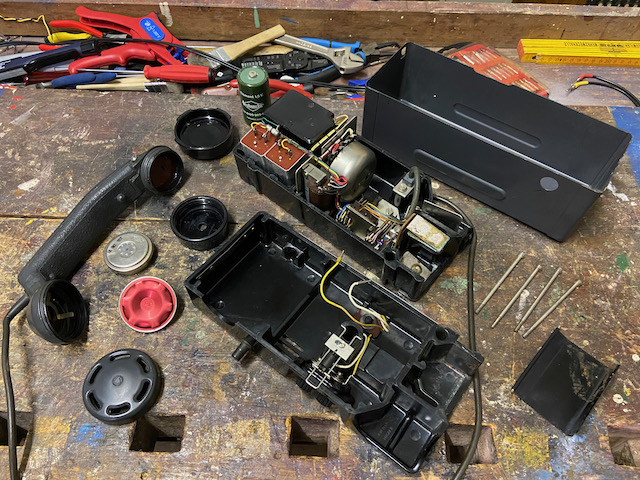
Albiswerk.
Left: magneto in black plastic case, capacitors from 1955.
Middle: ringer, coil, handset cable connected to microplug, between coil and handset plug the LB - CB switch.
Right: battery compartment.
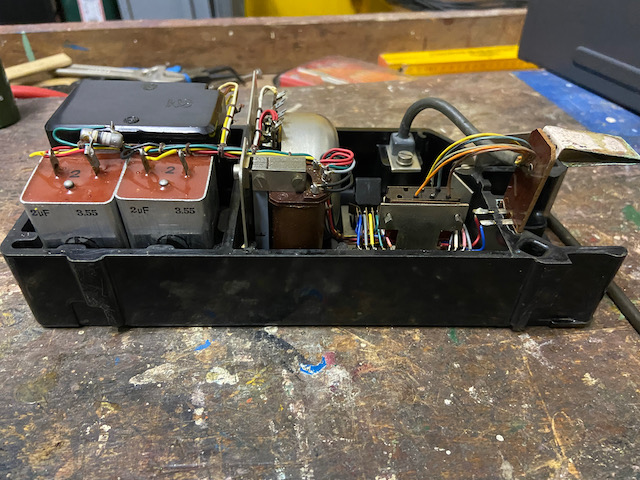
Gfeller disassembled.
Magneto in clear plastic case.
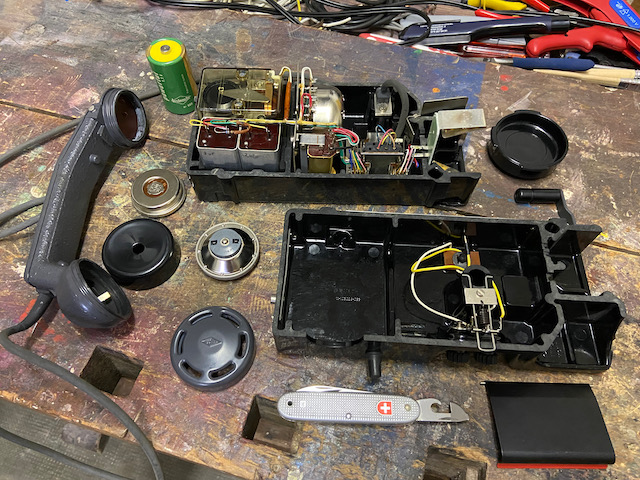
Gfeller.
Capacitors from 1977.
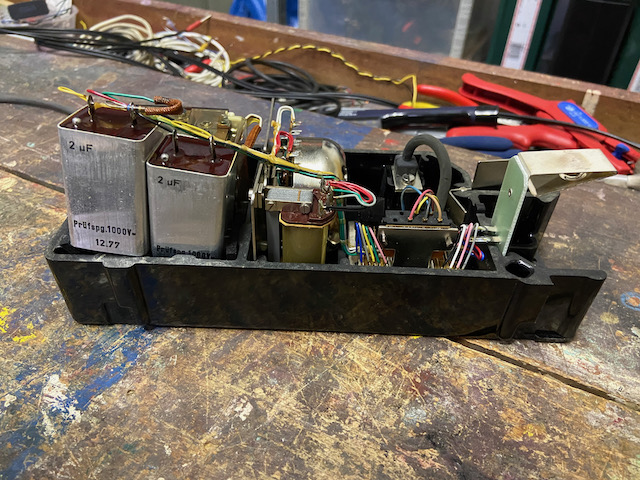
Left Gfeller, right Albiswerk.
The Albiswerk handset has still the original carbon transmitter, in the Gfeller one a dynamic transmitter made in 1985 by Philips is used.
It is assumed that instruments still in active use in the eighties got upgraded with this transmitter.
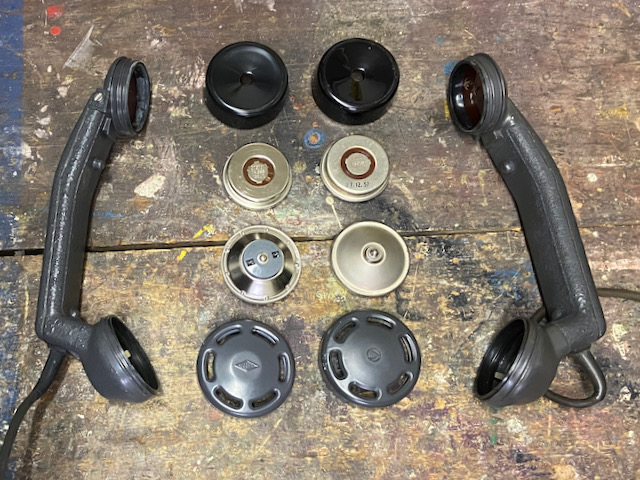
On top Albiswerk: T.Tf.-53, serial number "VA-S/U6", capacitors from 1955 (perhaps a Demo/Beta unit? But the internals are identical to any other unit with normal serial number).
Bottom Gfeller: A.Tf.-53, serial number "62664", capacitors from 1977.

Electrical diagram.
The "Ba" contacts are the LB - CB mode switch, here in LB mode.
"Gu" are the hook-switch contacts here in on-hook state (Gu = "Gabelumschalter" = Hook-switch).
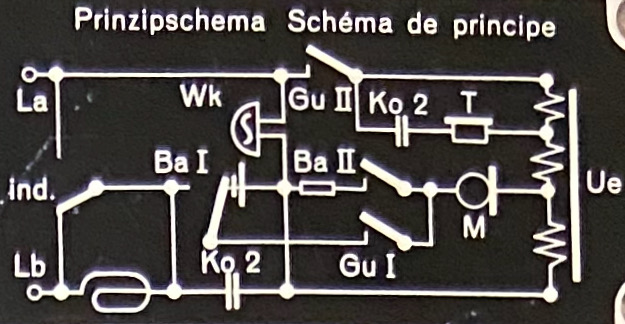
Stored crank, to unlock pull out the latch on instrument top (Fingernails work but better with pocket knife screw driver).

Ready to store.
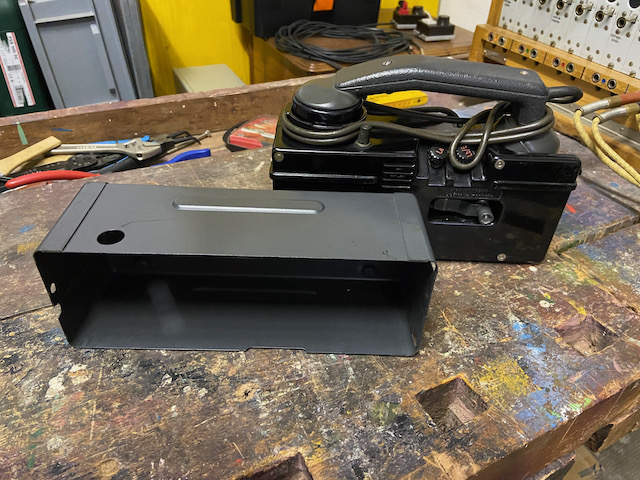
Ready for transport.

Dial unit mounted to A.Tf.53.
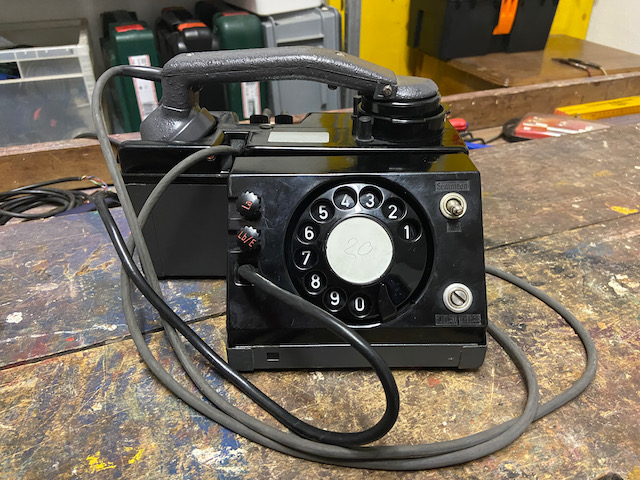
Dial unit mounted to F.Tf.50.

Dial unit with open back.
This one made in 1959.
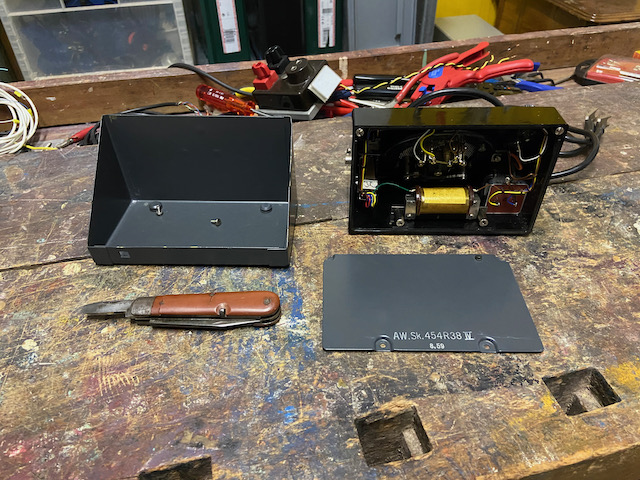
Left: hook-switch on top, mode switch below.
Middle: dial and holding coil.
Right: line connectors and capacitor.
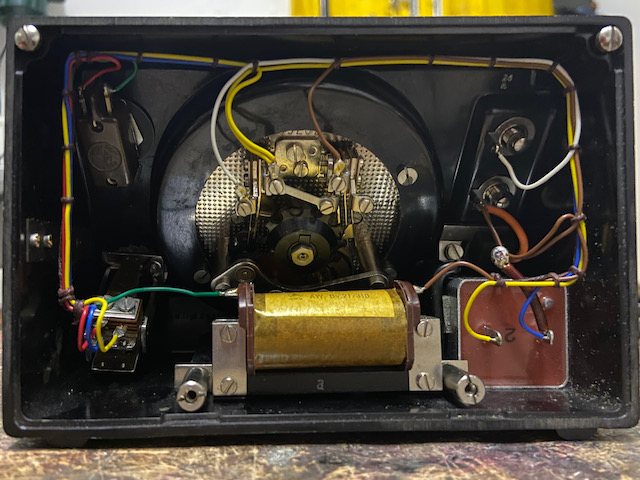
Dial marked "Sodeco Geneve".
Top switch: "Summton" (Dial tone) = off-hook; "Aus" (Off) = on-hook.
Bottom switch: "F.Tf.50" = holding coil and capacitor active; "T.Tf.50" = dial only.
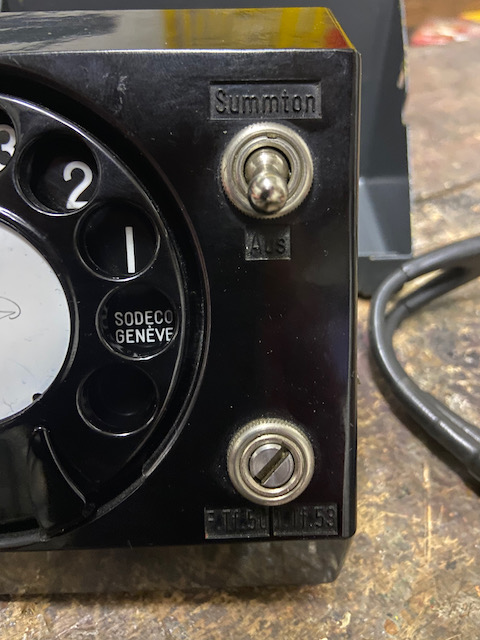
Electrical diagram and user guide in german and french.
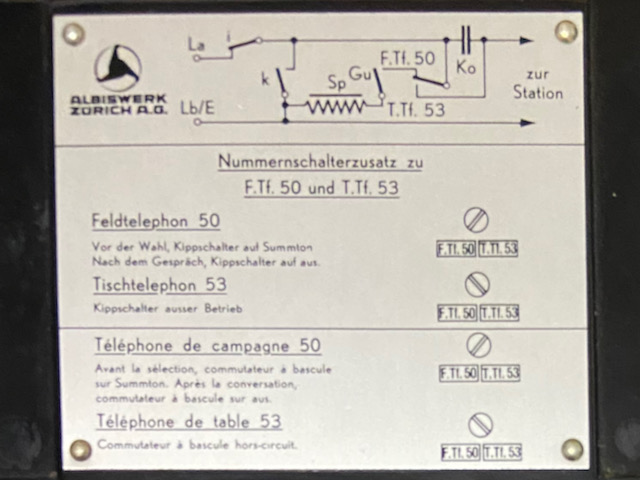
Ready to store.
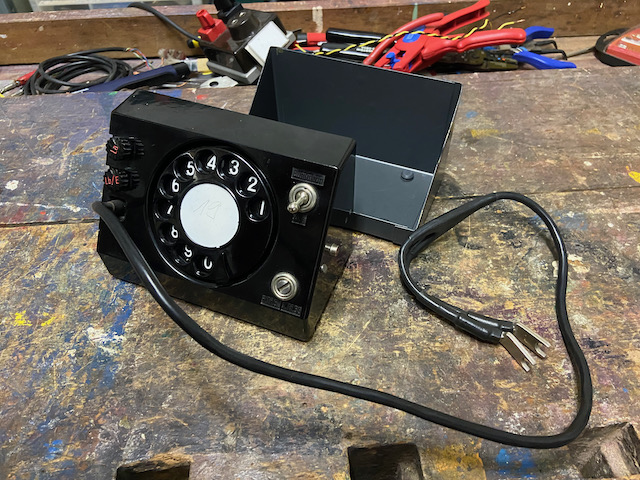
Ready for transport.
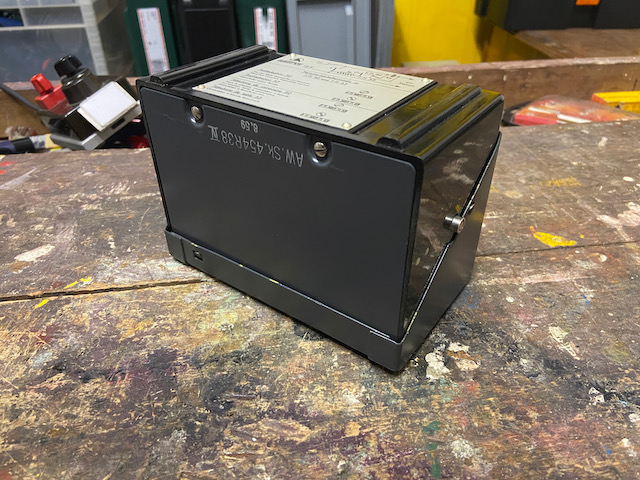
Gfeller from 1975 with label T.Tf.
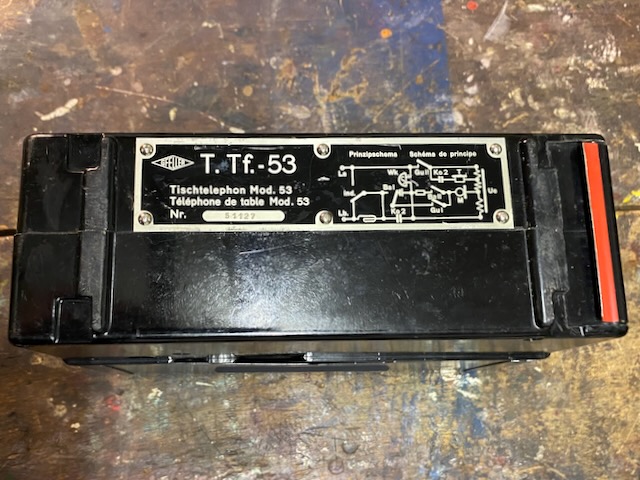
Gfeller with label T.Tf, Capacitors 1975.
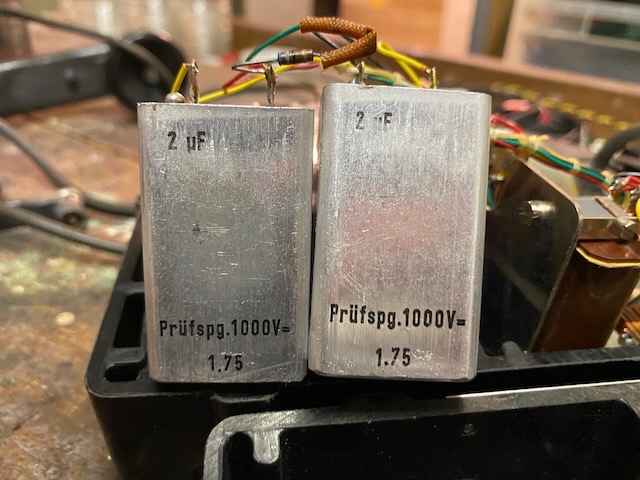
Gfeller from 1975 with label T.Tf, inside identical.
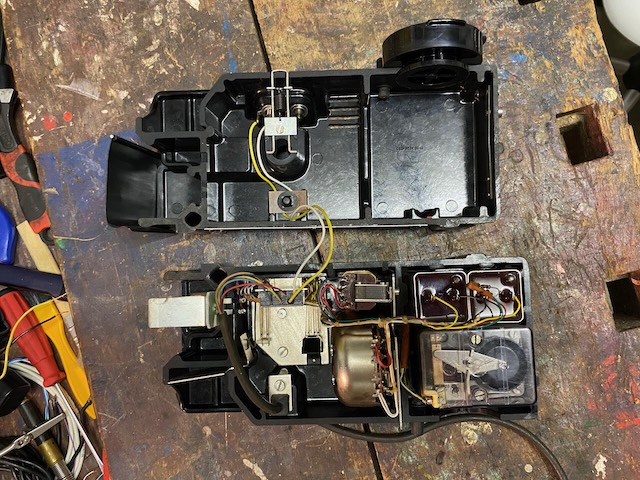
Creative Commons Attribution-ShareAlike 4.0 International License